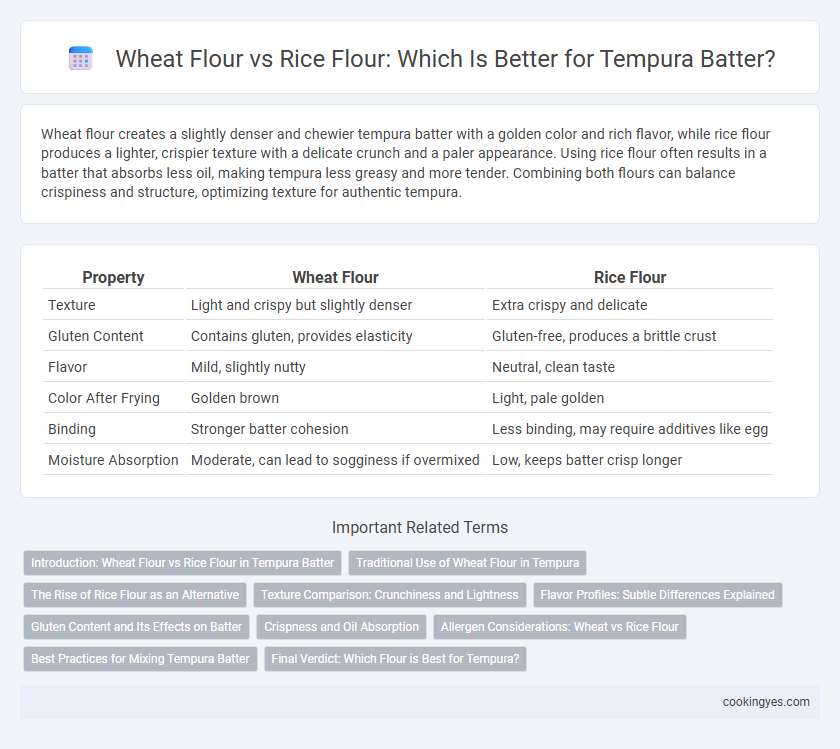Wheat flour creates a slightly denser and chewier tempura batter with a golden color and rich flavor, while rice flour produces a lighter, crispier texture with a delicate crunch and a paler appearance. Using rice flour often results in a batter that absorbs less oil, making tempura less greasy and more tender. Combining both flours can balance crispiness and structure, optimizing texture for authentic tempura.
Table of Comparison
| Property | Wheat Flour | Rice Flour |
|---|---|---|
| Texture | Light and crispy but slightly denser | Extra crispy and delicate |
| Gluten Content | Contains gluten, provides elasticity | Gluten-free, produces a brittle crust |
| Flavor | Mild, slightly nutty | Neutral, clean taste |
| Color After Frying | Golden brown | Light, pale golden |
| Binding | Stronger batter cohesion | Less binding, may require additives like egg |
| Moisture Absorption | Moderate, can lead to sogginess if overmixed | Low, keeps batter crisp longer |
Introduction: Wheat Flour vs Rice Flour in Tempura Batter
Wheat flour and rice flour each impact tempura batter's texture and crispiness differently, with wheat flour offering a softer, chewier bite due to its gluten content, while rice flour contributes to a lighter, crunchier coating. The lower protein level in rice flour reduces gluten formation, ideal for achieving the signature airy, crisp tempura exterior. Selecting between wheat and rice flour influences batter viscosity, frying behavior, and the final mouthfeel, essential for perfecting authentic tempura dishes.
Traditional Use of Wheat Flour in Tempura
Traditional tempura batter primarily uses wheat flour, prized for its moderate gluten content that creates a light, crispy texture when fried. Wheat flour's protein structure helps produce a delicate coating that adheres well without becoming heavy or greasy. This classic choice maintains the authentic tempura experience by balancing crispness and tenderness.
The Rise of Rice Flour as an Alternative
Rice flour has gained popularity as an alternative to wheat flour for tempura batter due to its ability to create a lighter, crispier texture that resists oil absorption better than traditional wheat flour. The absence of gluten in rice flour results in a delicate, airy coating, enhancing the tempura's signature crunch while maintaining a tender interior. This shift caters to gluten-sensitive consumers and those seeking a more refined, less greasy tempura experience.
Texture Comparison: Crunchiness and Lightness
Wheat flour tempura batter offers a balance of crispiness and slight chewiness, producing a crunch that is hearty yet tender. Rice flour tempura batter yields an exceptionally light and airy crust with pronounced crispness, often preferred for its delicate texture that enhances the tempura's overall lightness. Choosing between wheat and rice flour directly influences the tempura's mouthfeel, where wheat flour provides a denser crunch and rice flour ensures a lighter, more brittle crispness.
Flavor Profiles: Subtle Differences Explained
Wheat flour in tempura batter creates a light, crispy texture with a slightly nutty and sweet flavor, enhancing the natural taste of the ingredients. Rice flour yields a crisper and lighter batter with a neutral flavor profile, allowing the freshness of seafood or vegetables to stand out more distinctly. Choosing between wheat and rice flour impacts the overall flavor balance, with wheat adding mild sweetness and rice offering a cleaner, more delicate taste in tempura dishes.
Gluten Content and Its Effects on Batter
Wheat flour contains gluten, which provides elasticity and chewiness to tempura batter, resulting in a slightly denser and crisp texture. Rice flour is gluten-free, producing a lighter, crispier batter that remains delicate and airy when fried. Using rice flour reduces batter toughness, enhancing the signature crispness of traditional tempura.
Crispness and Oil Absorption
Wheat flour creates a tempura batter with a tender texture but tends to absorb more oil, leading to a heavier, less crisp result. Rice flour produces an exceptionally light and crispy tempura coating with minimal oil absorption, enhancing overall crunchiness. For optimal tempura batter, blending rice flour with wheat flour balances crispness and structural integrity while reducing greasiness.
Allergen Considerations: Wheat vs Rice Flour
Wheat flour, a common allergen, contains gluten, which can trigger reactions in individuals with celiac disease or wheat allergies, making it unsuitable for sensitive diners. Rice flour is naturally gluten-free and a safer alternative for those with wheat or gluten intolerance, reducing the risk of allergic responses in tempura batter. Choosing rice flour enhances allergen-friendly cooking while preserving the light, crispy texture essential to authentic tempura.
Best Practices for Mixing Tempura Batter
For the best tempura batter, using a combination of wheat flour and rice flour achieves optimal texture by balancing gluten development and crispiness. Wheat flour provides structure and slight chewiness, while rice flour contributes a light, airy crunch that prevents sogginess. Mixing cold water with these flours gently and avoiding over-mixing preserves the batter's delicate consistency, resulting in perfectly crispy and tender tempura.
Final Verdict: Which Flour is Best for Tempura?
Rice flour is preferred for tempura batter due to its ability to produce a lighter, crispier texture that resists absorbing excess oil. Wheat flour, while readily available and yielding a slightly denser coating, tends to create a heavier, less delicate tempura. For the classic tempura experience, rice flour stands out as the best choice to achieve the signature airy crunch.
Wheat flour vs rice flour for tempura batter Infographic

 cookingyes.com
cookingyes.com